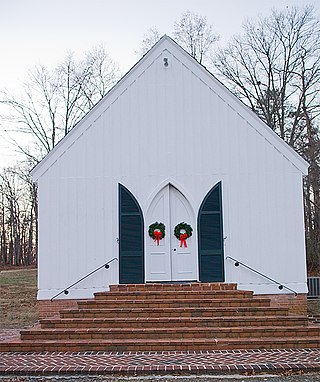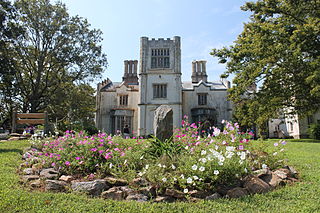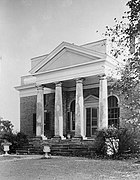
Fluvanna County is a county located in the Piedmont region of the Commonwealth of Virginia, United States. As of the 2020 census, the population was 27,249. Its county seat is Palmyra, while the most populous community is the census designated place of Lake Monticello.

George Washington Parke Custis was an American plantation owner, antiquarian, author, and playwright. His father John Parke Custis was the stepson of George Washington. He and his sister Eleanor grew up at Mount Vernon and in the Washington presidential household.
Buckingham Branch Railroad is a Class III short-line railroad operating over 275 miles (443 km) of historic and strategic trackage in Central Virginia. Sharing overhead traffic with CSX and Amtrak, the company's headquarters are in Dillwyn, Virginia in the former Chesapeake and Ohio Railroad (C&O) station, itself a historic landmark in the community. The railroad was featured in the January 2012 issue of Trains Magazine. It is referenced in the How It’s Made episode “Railway Bridge Ties”, showing it crossing a curved bridge.
Virginia Air Line Railroad (VAL) was a short-line railroad that operated from 1908 to 1975 in Central Virginia. It was built by the Virginia Air Line Railway Company to connect the Chesapeake and Ohio Railroad's (C&O) Piedmont Subdivision at Lindsay, Virginia, to the Rivanna Subdivision of C&O's James River Line at Strathmore Yard, near Bremo Bluff, Virginia.

Varina is a former unincorporated community and current magisterial district in the easternmost portion of Henrico County, Virginia, United States.

Mary Anna Randolph Custis Lee was the wife of the Confederate general Robert E. Lee and the last private owner of Arlington Estate. She was the daughter of George Washington Parke Custis who was the grandson of Martha Dandridge Custis Washington, the wife of George Washington.

U.S. Route 15 (US 15) is a part of the United States Numbered Highway System that runs from Walterboro, South Carolina, to Painted Post, New York. In Virginia, the U.S. Highway runs 230.37 miles (370.74 km) from the North Carolina state line near Clarksville north to the Maryland state line at the Potomac River near Lucketts. US 15 is a major north–south highway through the Piedmont of Virginia, connecting Clarksville and Farmville in Southside with Culpeper, Warrenton, and Leesburg in Northern Virginia.

Edward Randolph, sometimes referred to as Edward Randolph of Bremo, was a ship captain, a London tobacco merchant, and the seventh and youngest son of William Randolph and Mary Isham.

Bremo Slave Chapel, constructed in 1835 and located in Bremo Bluff, Virginia, United States, is the only slave chapel known to exist in the Commonwealth of Virginia. This Gothic Revival structure originally served as a place of worship for the slaves at the Bremo Plantation of General John Hartwell Cocke. Cocke was deeply concerned with the religious and moral state of his slaves, which drove him to construct this chapel.

Bremo, also known as Bremo Plantation or Bremo Historic District, is a plantation estate covering over 1,500 acres (610 ha) on the west side of Bremo Bluff in Fluvanna County, Virginia. The plantation includes three separate estates, all created in the 19th century by the planter, soldier, and reformer John Hartwell Cocke on his family's 1725 land grant. The large neo-palladian mansion at "Upper" Bremo was designed by Cocke in consultation with John Neilson, a master joiner for Thomas Jefferson's Monticello. The Historic District also includes two smaller residences known as Lower Bremo and Bremo Recess.

Philip St. George Cocke was a brigadier general in the Confederate States Army during the first year of the American Civil War. He is best known for organizing the defense of Virginia along the Potomac River soon after the state's secession from the Union. He commanded troops in the Battle of Blackburn's Ford and the First Battle of Bull Run in July 1861 before becoming despondent and committing suicide.

Brigadier-General John Hartwell Cocke II was an American military officer, planter and businessman. During the War of 1812, Cocke served in the Virginia militia. After his military service, he invested in the James River and Kanawha Canal and helped Thomas Jefferson establish the University of Virginia. The family estate that Cocke built at Bremo Plantation is now a National Historic Landmark.
Carysbrook is an unincorporated community in Fluvanna County, in the U.S. state of Virginia.
Cohasset is an unincorporated community in Fluvanna County, in the U.S. state of Virginia located about two miles west of Fork Union on State Route 6.

Glen Arvon, originally known as Glenarvon, is a historic plantation house and farm located near Bremo Bluff, Fluvanna County, Virginia. The main house was built in 1836, and is a two-story, five bay, brick dwelling in the Greek Revival style. It measures 50 feet by 40 feet and is topped by a shallow hipped roof with balustrade. The front facade features a two-story Greek Doric order portico. Also on the property is the contributing two-story, brick servant's house. The house is a twin of Point of Fork, as they were built by brothers William and James Galt.

Belmead is a historic plantation located near Powhatan, Powhatan County, Virginia, designed by architect Alexander Jackson Davis for Philip St. George Cocke — and constructed about 1845.

The Seven Islands Archeological and Historic District encompasses a 312-acre (126 ha) site near the confluence of the James and Slate Rivers in Buckingham and Fluvanna Counties in Virginia. The site is notable for a number of prehistoric archaeological sites, the largest of which is a Woodland period Native American site, while smaller sites from earlier periods also exist in the area. The site is also notable for the Seven Islands house, a well-preserved Greek Revival I-house. It is situated on a bluff in Buckingham County with commanding views of the James River, across from the Bremo Plantation.

The Swann's Point Plantation Site is an archaeological site near the James River in Surry County, Virginia. The Swann's Point area, located west of the mouth of Gray Creek, has a rich historic of precolonial Native American occupation, as well as significant early colonial settlements. It was first granted to Richard Pace, whose warning famously saved the Jamestown Colony during the Indian Massacre of 1622. The Paces abandoned their settlement in 1624.
The John H. Cocke Memorial Bridge is a bridge along U.S. Route 15 in the state of Virginia that crosses over the James River. Its northern terminus is at Bremo Bluff, VA and the Bremo Historic District in southern Fluvanna County and its southern terminus is at New Canton, Virginia in northern Buckingham County. The bridge is named in honor of John Hartwell Cocke, a notable Virginian whose Bremo Plantation was nearby and who once owned the property on which it was built.
John Neilson (c.1770—1827) was an Irish immigrant to the United States who eventually settled in Virginia and became a prominent 19th-century master carpenter and joiner, as well as architect and builder. He is most known for his work at Monticello, Montpelier, Bremo, and the University of Virginia.




















